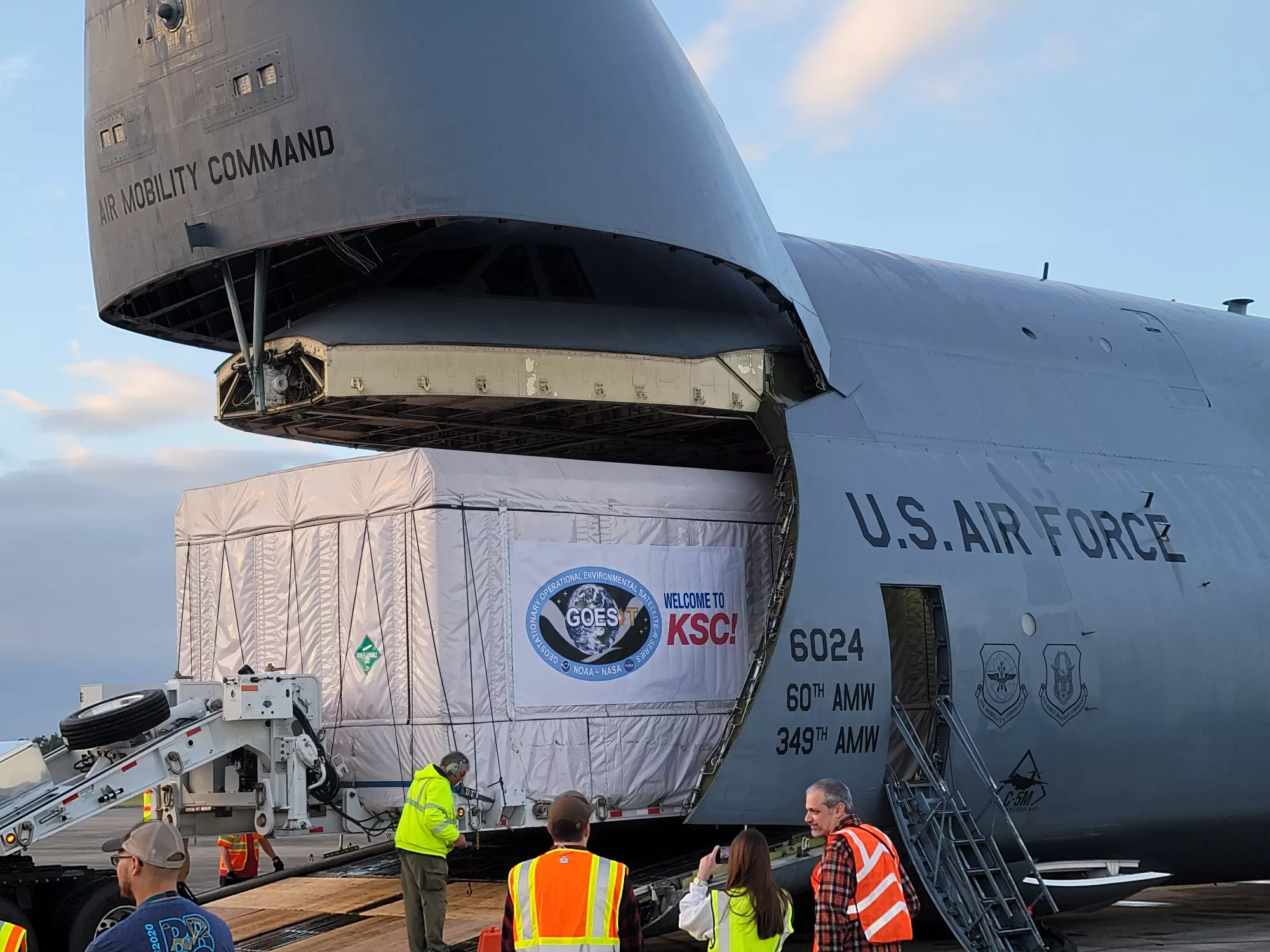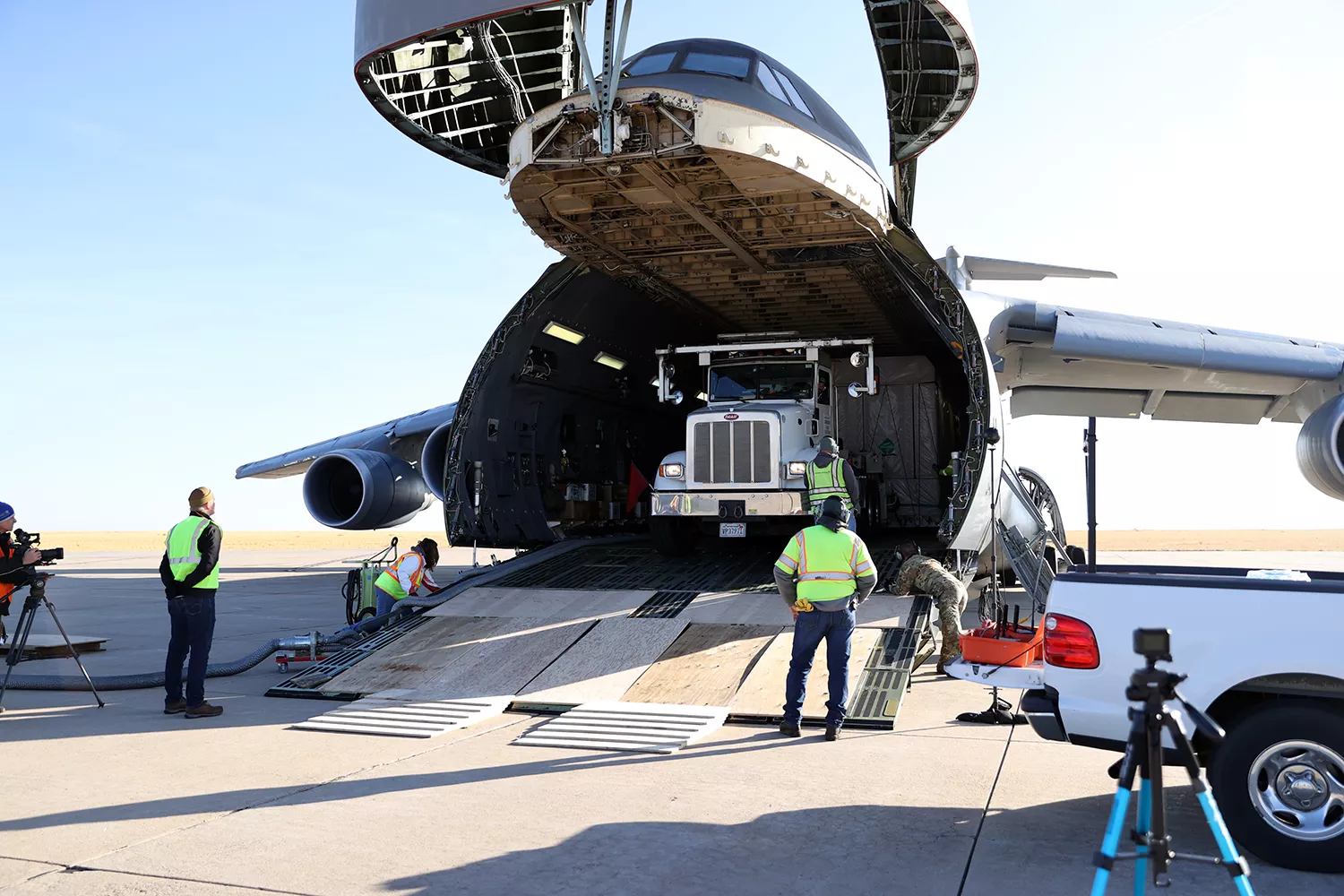NOAA’s GOES-T Satellite 2022 Launch Scheduled
Special Stories
1 Dec 2021 7:40 PM
[Written by NOAA NESDIS] NOAA’s GOES-T, the third in the GOES-R Series of advanced weather observing and environmental monitoring satellites, arrived in Florida today to begin final preparations for launch, which is currently scheduled for March 1, 2022. The launch was recently scheduled for February 16, 2022. However, shifts in launch dates for missions scheduled ahead of GOES-T prompted NASA, NOAA, and United Launch Alliance (ULA) to coordinate the new date.
[The GOES-T satellite is unloaded from the C-5 Super Galaxy cargo aircraft that flew it to the Kennedy Space Center in Florida on Nov. 10, 2021. Credit: Dan Lindsey]
Shipping a satellite is no small feat. GOES-T is the size of a small school bus and weighs over 6,000 pounds! The spacecraft team at Lockheed Martin in Littleton, Colorado, where GOES-T was built, carefully packed the satellite in a special shipping container that protected its sensitive instruments and functioned as a miniature clean room during transport. GOES-T was then driven to Buckley Space Force Base in Aurora, Colorado, where it hitched a ride aboard a C-5 Super Galaxy aircraft to Kennedy Space Center.
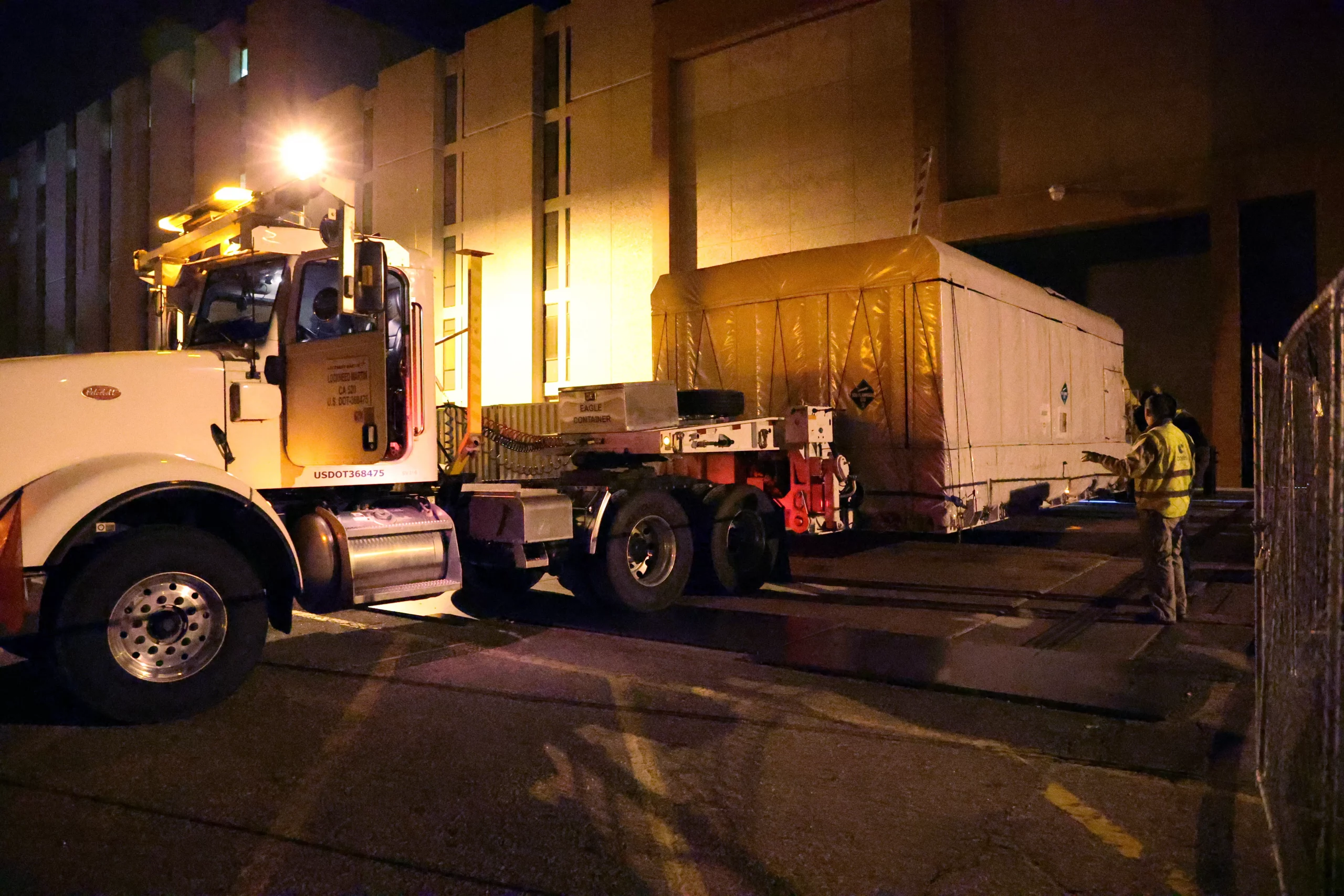 [GOES-T departs Lockheed Martin Space Systems in Littleton, Colorado on Nov. 9, 2021, encased in its special shipping container onboard an 18-wheeler. It will be driven to Buckley Space Force Base in Aurora to meet its ride to Florida. Credit: NASA/Elizabeth Wilk]
GOES-T was then transported to a clean room at the Astrotech Space Operations spacecraft processing facility in nearby Titusville, where it was unpacked. The satellite will now undergo final preparations for an early 2022 launch from Cape Canaveral Space Force Station. GOES-T will launch aboard a United Launch Alliance Atlas V 541 rocket from Space Launch Complex-41.
[GOES-T departs Lockheed Martin Space Systems in Littleton, Colorado on Nov. 9, 2021, encased in its special shipping container onboard an 18-wheeler. It will be driven to Buckley Space Force Base in Aurora to meet its ride to Florida. Credit: NASA/Elizabeth Wilk]
GOES-T was then transported to a clean room at the Astrotech Space Operations spacecraft processing facility in nearby Titusville, where it was unpacked. The satellite will now undergo final preparations for an early 2022 launch from Cape Canaveral Space Force Station. GOES-T will launch aboard a United Launch Alliance Atlas V 541 rocket from Space Launch Complex-41.
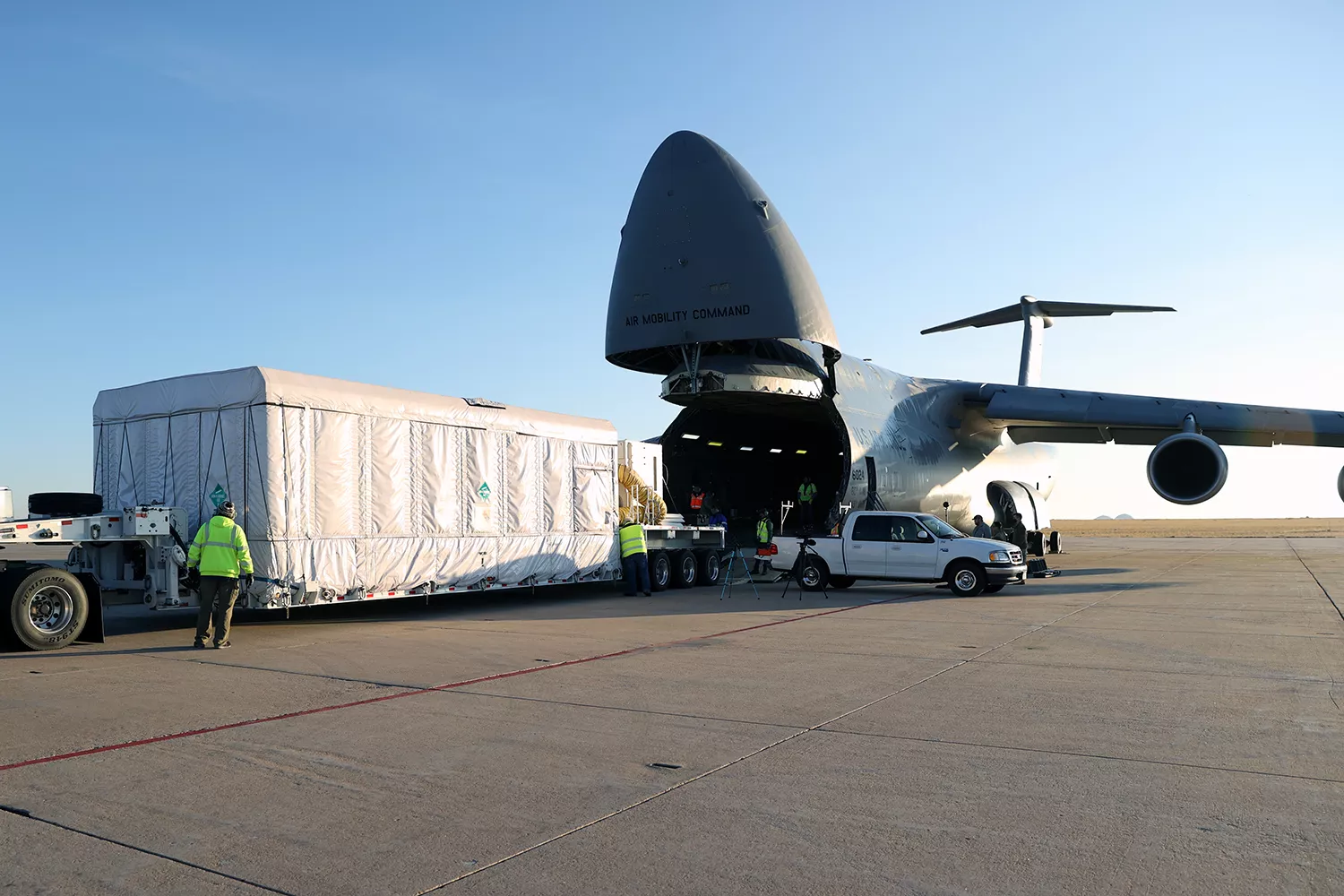 [After a careful ride on a truck from Lockheed Martin, crews prepare to load GOES-T into a U.S. Air Force C-5 Super Galaxy aircraft at Buckley Space Force Base in Aurora on Nov. 9, 2021. Credit: NASA/Elizabeth Wilk]
[The truck towing GOES-T carefully backs it into the belly of the U.S. Air Force C-5 Super Galaxy transport at Buckley Space Force Base in Aurora on Nov. 9, 2021. The satellite will then be flown to the Kennedy Space Center in Florida. Credit: NASA/Elizabeth Wilk]
Upon reaching geostationary orbit after launch, GOES-T will be renamed GOES-18. After it completes checkout of its instruments and systems, the new satellite will go into operation as GOES West, replacing the current GOES-17. In the GOES West position, GOES-18 will watch over the U.S. West Coast, Alaska, Hawaii, Mexico, Central America, and the Pacific Ocean extending to Guam. The satellite will be ideally located to detect and monitor weather systems and environmental hazards that most affect this region of the Western Hemisphere, including wildfires, atmospheric rivers, coastal fog, dust storms, and volcanic eruptions. GOES-18 will also monitor the sun for solar eruptions and detect space weather hazards that can disrupt communications, navigation systems, and power utilities on Earth.
[After a careful ride on a truck from Lockheed Martin, crews prepare to load GOES-T into a U.S. Air Force C-5 Super Galaxy aircraft at Buckley Space Force Base in Aurora on Nov. 9, 2021. Credit: NASA/Elizabeth Wilk]
[The truck towing GOES-T carefully backs it into the belly of the U.S. Air Force C-5 Super Galaxy transport at Buckley Space Force Base in Aurora on Nov. 9, 2021. The satellite will then be flown to the Kennedy Space Center in Florida. Credit: NASA/Elizabeth Wilk]
Upon reaching geostationary orbit after launch, GOES-T will be renamed GOES-18. After it completes checkout of its instruments and systems, the new satellite will go into operation as GOES West, replacing the current GOES-17. In the GOES West position, GOES-18 will watch over the U.S. West Coast, Alaska, Hawaii, Mexico, Central America, and the Pacific Ocean extending to Guam. The satellite will be ideally located to detect and monitor weather systems and environmental hazards that most affect this region of the Western Hemisphere, including wildfires, atmospheric rivers, coastal fog, dust storms, and volcanic eruptions. GOES-18 will also monitor the sun for solar eruptions and detect space weather hazards that can disrupt communications, navigation systems, and power utilities on Earth.
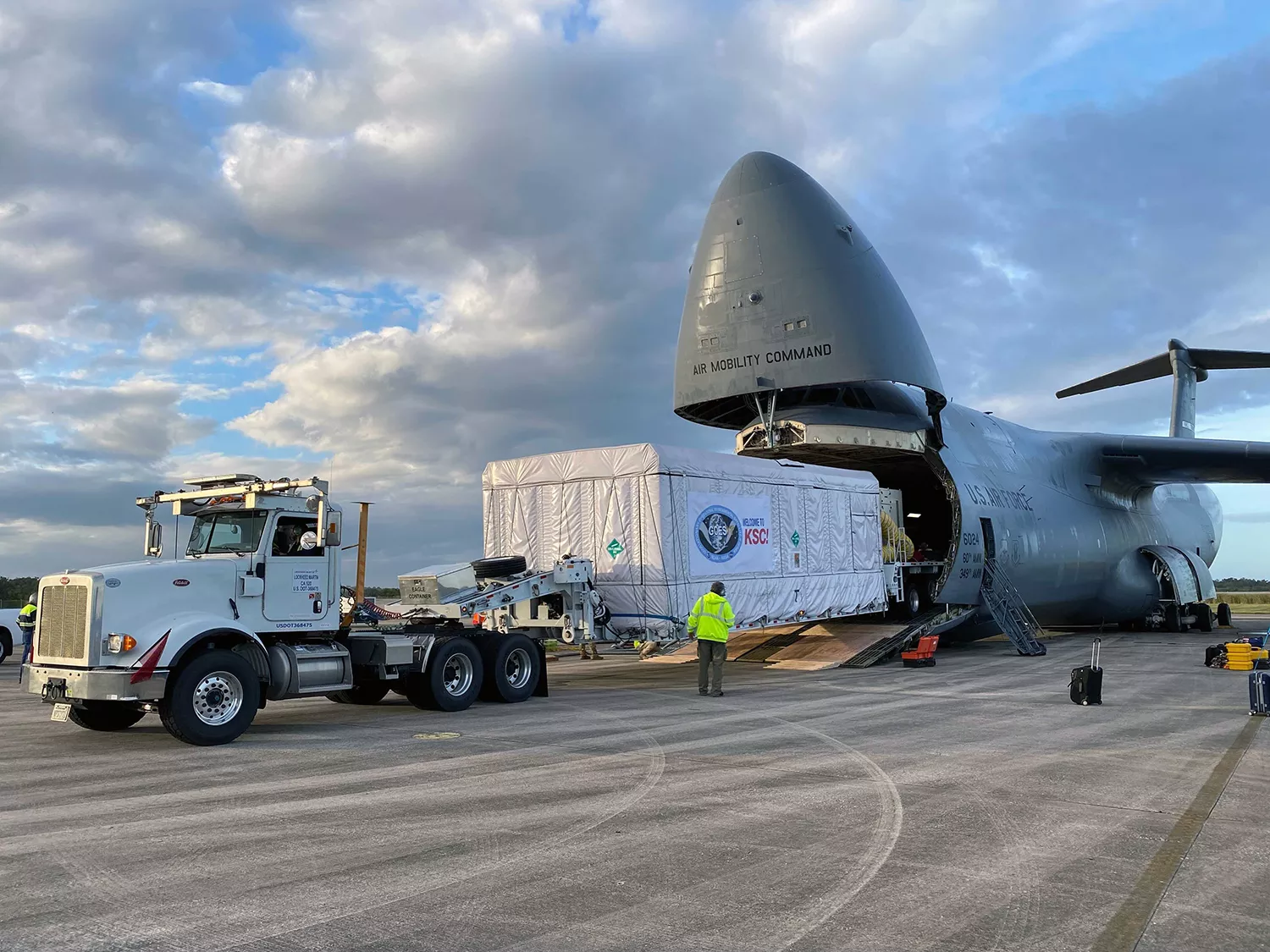 [After arriving at the Kennedy Space Center in Florida on Nov. 10, 2021, technicians slowly bring GOES-T off the aircraft for a short drive to Astrotech Space Operations in Titusville. Credit: NASA/Elizabeth Wilk]
[After arriving at the Kennedy Space Center in Florida on Nov. 10, 2021, technicians slowly bring GOES-T off the aircraft for a short drive to Astrotech Space Operations in Titusville. Credit: NASA/Elizabeth Wilk]
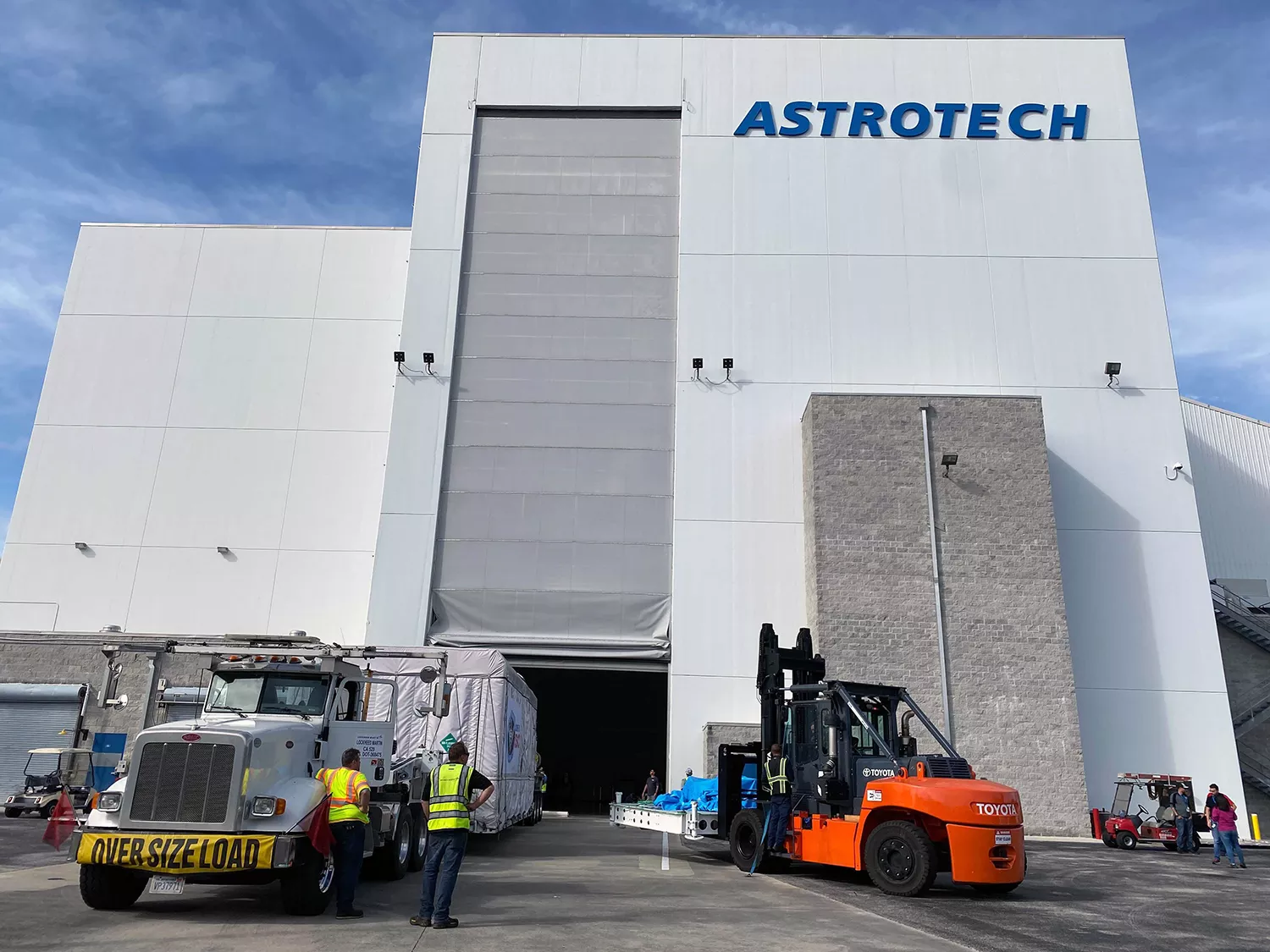 [GOES-T arrives at Astrotech Space Operations in Titusville, Florida. Here, it will be removed from its shipping container to be inspected. Credit: NASA/Elizabeth Wilk]
NOAA oversees the GOES-R Series Program through an integrated NOAA-NASA office, operating the satellites, managing the ground system, and distributing the satellite data to users worldwide. NASA’s Goddard Space Flight Center oversees the acquisition of the GOES-R spacecraft and instruments and NASA’s Launch Services Program, based at Kennedy Space Center, launches the satellites. Lockheed Martin designs, builds, and tests the GOES-R Series satellites. L3Harris Technologies provides the main instrument payload, the Advanced Baseline Imager, along with the ground system, which includes the antenna system for data reception.
[GOES-T arrives at Astrotech Space Operations in Titusville, Florida. Here, it will be removed from its shipping container to be inspected. Credit: NASA/Elizabeth Wilk]
NOAA oversees the GOES-R Series Program through an integrated NOAA-NASA office, operating the satellites, managing the ground system, and distributing the satellite data to users worldwide. NASA’s Goddard Space Flight Center oversees the acquisition of the GOES-R spacecraft and instruments and NASA’s Launch Services Program, based at Kennedy Space Center, launches the satellites. Lockheed Martin designs, builds, and tests the GOES-R Series satellites. L3Harris Technologies provides the main instrument payload, the Advanced Baseline Imager, along with the ground system, which includes the antenna system for data reception.
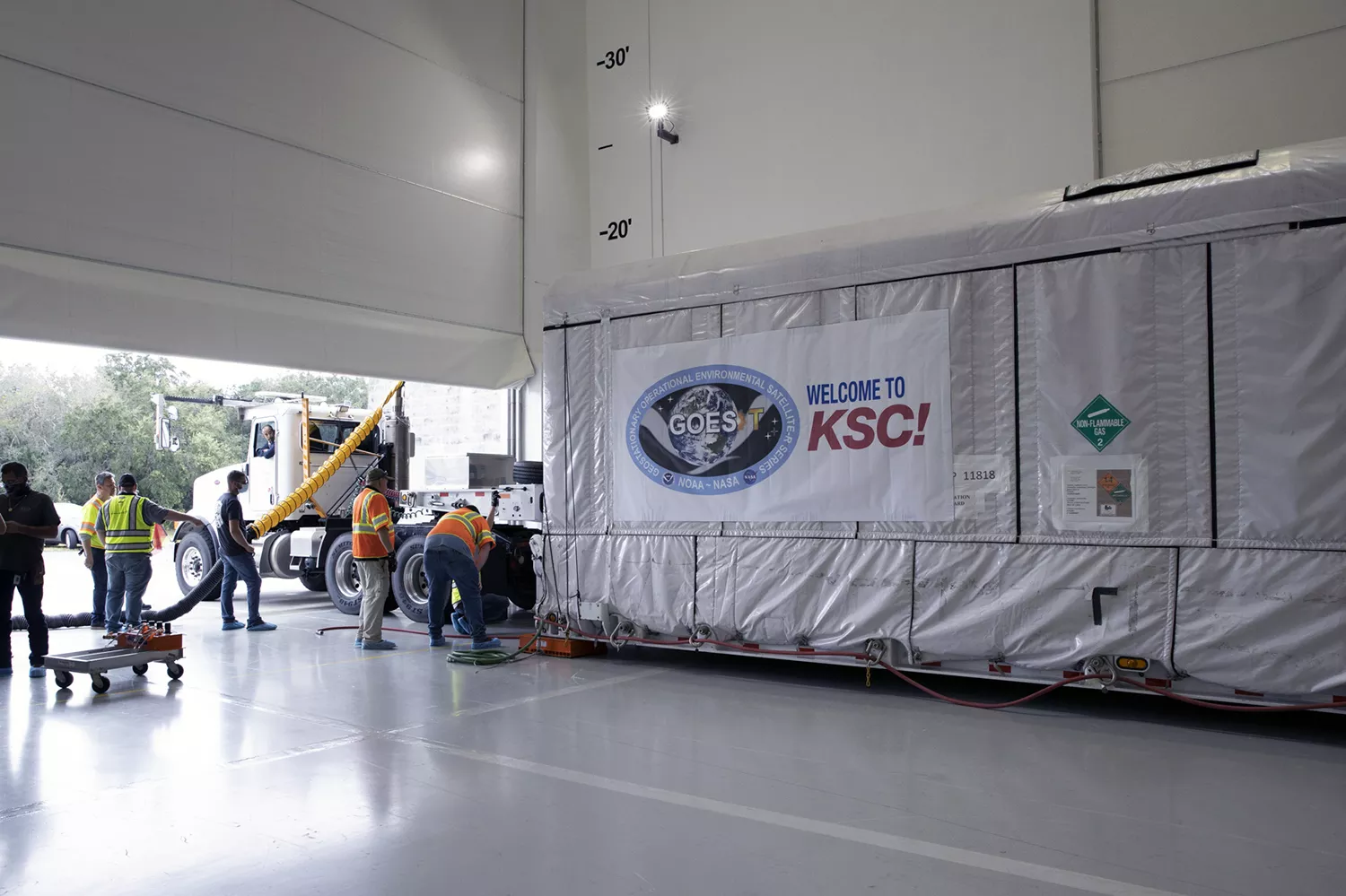
 [GOES-T departs Lockheed Martin Space Systems in Littleton, Colorado on Nov. 9, 2021, encased in its special shipping container onboard an 18-wheeler. It will be driven to Buckley Space Force Base in Aurora to meet its ride to Florida. Credit: NASA/Elizabeth Wilk]
GOES-T was then transported to a clean room at the Astrotech Space Operations spacecraft processing facility in nearby Titusville, where it was unpacked. The satellite will now undergo final preparations for an early 2022 launch from Cape Canaveral Space Force Station. GOES-T will launch aboard a United Launch Alliance Atlas V 541 rocket from Space Launch Complex-41.
[GOES-T departs Lockheed Martin Space Systems in Littleton, Colorado on Nov. 9, 2021, encased in its special shipping container onboard an 18-wheeler. It will be driven to Buckley Space Force Base in Aurora to meet its ride to Florida. Credit: NASA/Elizabeth Wilk]
GOES-T was then transported to a clean room at the Astrotech Space Operations spacecraft processing facility in nearby Titusville, where it was unpacked. The satellite will now undergo final preparations for an early 2022 launch from Cape Canaveral Space Force Station. GOES-T will launch aboard a United Launch Alliance Atlas V 541 rocket from Space Launch Complex-41.
 [After a careful ride on a truck from Lockheed Martin, crews prepare to load GOES-T into a U.S. Air Force C-5 Super Galaxy aircraft at Buckley Space Force Base in Aurora on Nov. 9, 2021. Credit: NASA/Elizabeth Wilk]
[The truck towing GOES-T carefully backs it into the belly of the U.S. Air Force C-5 Super Galaxy transport at Buckley Space Force Base in Aurora on Nov. 9, 2021. The satellite will then be flown to the Kennedy Space Center in Florida. Credit: NASA/Elizabeth Wilk]
[After a careful ride on a truck from Lockheed Martin, crews prepare to load GOES-T into a U.S. Air Force C-5 Super Galaxy aircraft at Buckley Space Force Base in Aurora on Nov. 9, 2021. Credit: NASA/Elizabeth Wilk]
[The truck towing GOES-T carefully backs it into the belly of the U.S. Air Force C-5 Super Galaxy transport at Buckley Space Force Base in Aurora on Nov. 9, 2021. The satellite will then be flown to the Kennedy Space Center in Florida. Credit: NASA/Elizabeth Wilk]
 [After arriving at the Kennedy Space Center in Florida on Nov. 10, 2021, technicians slowly bring GOES-T off the aircraft for a short drive to Astrotech Space Operations in Titusville. Credit: NASA/Elizabeth Wilk]
[After arriving at the Kennedy Space Center in Florida on Nov. 10, 2021, technicians slowly bring GOES-T off the aircraft for a short drive to Astrotech Space Operations in Titusville. Credit: NASA/Elizabeth Wilk]


[The GOES-T satellite is carefully brought inside Astrotech Space Operations' payload processing facility, where it will be taken out of its shipping container and inspected. Credit: NASA/Elizabeth Wilk]
 [Crews bring GOES-T into a clean room at Astrotech Space Operations' payload processing facility and prepare to remove it from its shipping container for inspection. Credit: NASA/Elizabeth Wilk]
GOES-T will launch from Cape Canaveral Space Force Station on a ULA Atlas V 541 rocket. The two-hour launch window will open at 4:38 p.m. EST. NASA’s Launch Services Program is managing the launch.
[Crews bring GOES-T into a clean room at Astrotech Space Operations' payload processing facility and prepare to remove it from its shipping container for inspection. Credit: NASA/Elizabeth Wilk]
GOES-T will launch from Cape Canaveral Space Force Station on a ULA Atlas V 541 rocket. The two-hour launch window will open at 4:38 p.m. EST. NASA’s Launch Services Program is managing the launch.
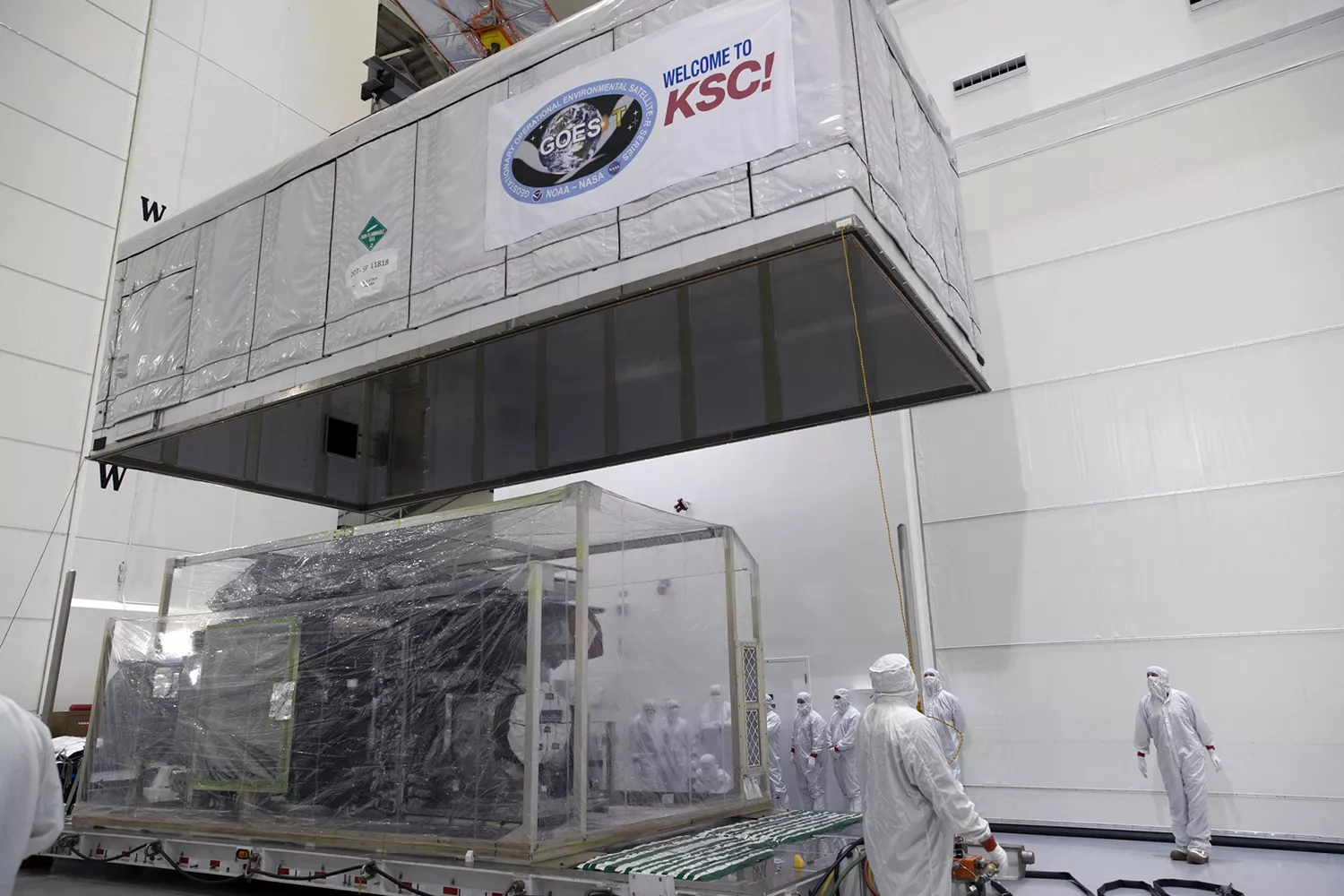 [Staff open GOES-T's shipping container within a clean room at Astrotech Space Operations' payload processing facility. Credit: NASA/Elizabeth Wilk]
NOAA manages the GOES-R Series Program through an integrated NOAA-NASA office, administering the ground system contract, operating the satellites, and distributing their data to users worldwide. NASA’s Goddard Space Flight Center oversees the acquisition of the GOES-R spacecraft and instruments. Lockheed Martin designs, creates, and tests the GOES-R series satellites. L3Harris Technologies provides the main instrument payload, the Advanced Baseline Imager, along with the ground system, which includes the antenna system for data reception.
[Staff open GOES-T's shipping container within a clean room at Astrotech Space Operations' payload processing facility. Credit: NASA/Elizabeth Wilk]
NOAA manages the GOES-R Series Program through an integrated NOAA-NASA office, administering the ground system contract, operating the satellites, and distributing their data to users worldwide. NASA’s Goddard Space Flight Center oversees the acquisition of the GOES-R spacecraft and instruments. Lockheed Martin designs, creates, and tests the GOES-R series satellites. L3Harris Technologies provides the main instrument payload, the Advanced Baseline Imager, along with the ground system, which includes the antenna system for data reception.
 [Technicians take a first look at GOES-T once the cover of its shipping container has been removed. Credit: NASA/Elizabeth Wilk]
Looking forward, NOAA is working with NASA on the next-generation geostationary satellite mission called GeoXO, which will bring new capabilities in support of U.S. weather, ocean, and climate operations in the 2030s. NASA will manage the development of the GeoXO satellites and launch them for NOAA.
[Technicians take a first look at GOES-T once the cover of its shipping container has been removed. Credit: NASA/Elizabeth Wilk]
Looking forward, NOAA is working with NASA on the next-generation geostationary satellite mission called GeoXO, which will bring new capabilities in support of U.S. weather, ocean, and climate operations in the 2030s. NASA will manage the development of the GeoXO satellites and launch them for NOAA.
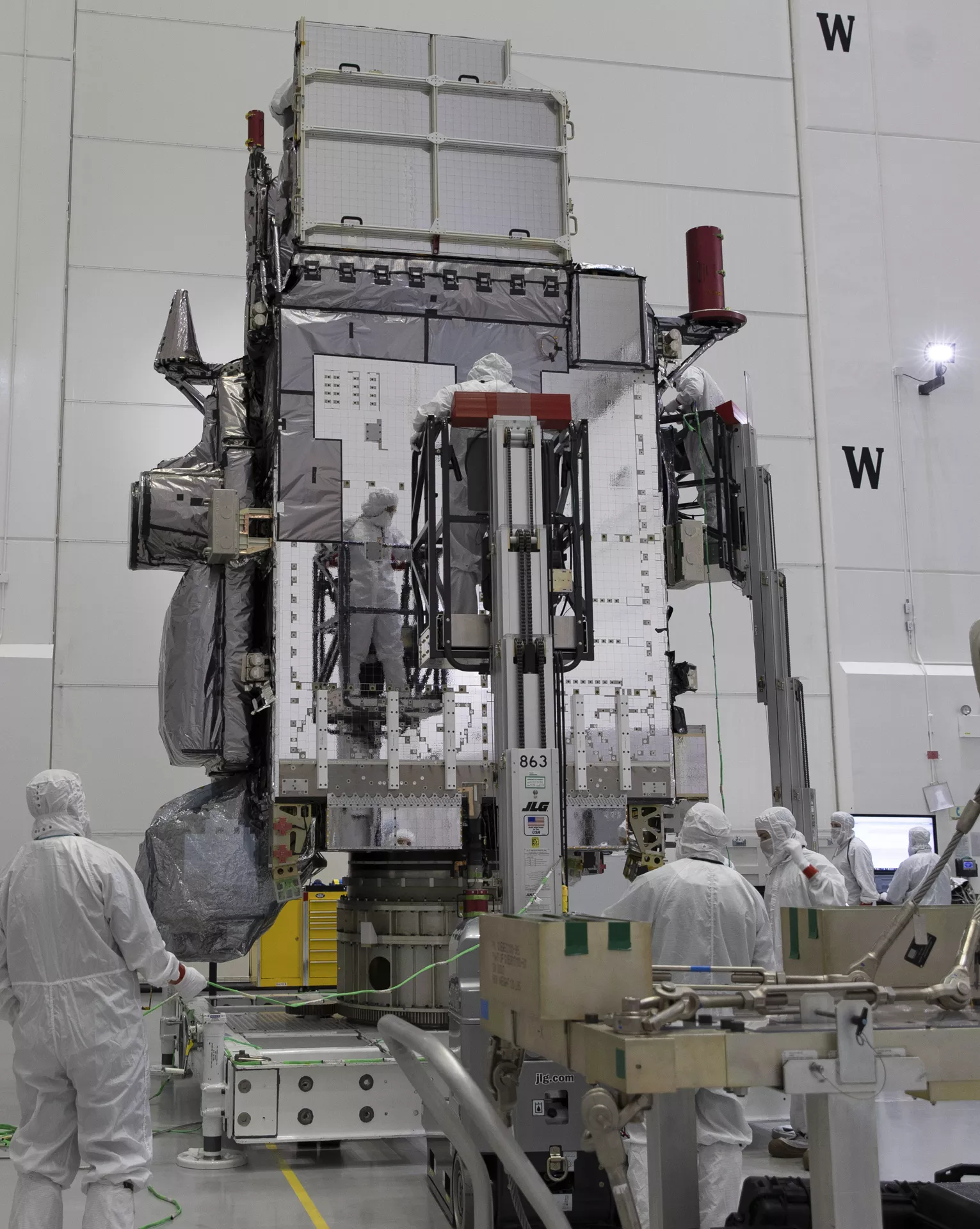 [Technicians set GOES-T's chassis up on a stand within the clean room at Astrotech Space Operations' payload processing facility. Credit: NASA/Elizabeth Wilk]
https://www.youtube.com/watch?v=9ZpP9gNJteM
Edited for WeatherNation by Mace Michaels
[Technicians set GOES-T's chassis up on a stand within the clean room at Astrotech Space Operations' payload processing facility. Credit: NASA/Elizabeth Wilk]
https://www.youtube.com/watch?v=9ZpP9gNJteM
Edited for WeatherNation by Mace Michaels
 [Crews bring GOES-T into a clean room at Astrotech Space Operations' payload processing facility and prepare to remove it from its shipping container for inspection. Credit: NASA/Elizabeth Wilk]
GOES-T will launch from Cape Canaveral Space Force Station on a ULA Atlas V 541 rocket. The two-hour launch window will open at 4:38 p.m. EST. NASA’s Launch Services Program is managing the launch.
[Crews bring GOES-T into a clean room at Astrotech Space Operations' payload processing facility and prepare to remove it from its shipping container for inspection. Credit: NASA/Elizabeth Wilk]
GOES-T will launch from Cape Canaveral Space Force Station on a ULA Atlas V 541 rocket. The two-hour launch window will open at 4:38 p.m. EST. NASA’s Launch Services Program is managing the launch.
 [Staff open GOES-T's shipping container within a clean room at Astrotech Space Operations' payload processing facility. Credit: NASA/Elizabeth Wilk]
NOAA manages the GOES-R Series Program through an integrated NOAA-NASA office, administering the ground system contract, operating the satellites, and distributing their data to users worldwide. NASA’s Goddard Space Flight Center oversees the acquisition of the GOES-R spacecraft and instruments. Lockheed Martin designs, creates, and tests the GOES-R series satellites. L3Harris Technologies provides the main instrument payload, the Advanced Baseline Imager, along with the ground system, which includes the antenna system for data reception.
[Staff open GOES-T's shipping container within a clean room at Astrotech Space Operations' payload processing facility. Credit: NASA/Elizabeth Wilk]
NOAA manages the GOES-R Series Program through an integrated NOAA-NASA office, administering the ground system contract, operating the satellites, and distributing their data to users worldwide. NASA’s Goddard Space Flight Center oversees the acquisition of the GOES-R spacecraft and instruments. Lockheed Martin designs, creates, and tests the GOES-R series satellites. L3Harris Technologies provides the main instrument payload, the Advanced Baseline Imager, along with the ground system, which includes the antenna system for data reception.
 [Technicians take a first look at GOES-T once the cover of its shipping container has been removed. Credit: NASA/Elizabeth Wilk]
Looking forward, NOAA is working with NASA on the next-generation geostationary satellite mission called GeoXO, which will bring new capabilities in support of U.S. weather, ocean, and climate operations in the 2030s. NASA will manage the development of the GeoXO satellites and launch them for NOAA.
[Technicians take a first look at GOES-T once the cover of its shipping container has been removed. Credit: NASA/Elizabeth Wilk]
Looking forward, NOAA is working with NASA on the next-generation geostationary satellite mission called GeoXO, which will bring new capabilities in support of U.S. weather, ocean, and climate operations in the 2030s. NASA will manage the development of the GeoXO satellites and launch them for NOAA.
 [Technicians set GOES-T's chassis up on a stand within the clean room at Astrotech Space Operations' payload processing facility. Credit: NASA/Elizabeth Wilk]
https://www.youtube.com/watch?v=9ZpP9gNJteM
Edited for WeatherNation by Mace Michaels
[Technicians set GOES-T's chassis up on a stand within the clean room at Astrotech Space Operations' payload processing facility. Credit: NASA/Elizabeth Wilk]
https://www.youtube.com/watch?v=9ZpP9gNJteM
Edited for WeatherNation by Mace Michaels
All Weather News
More